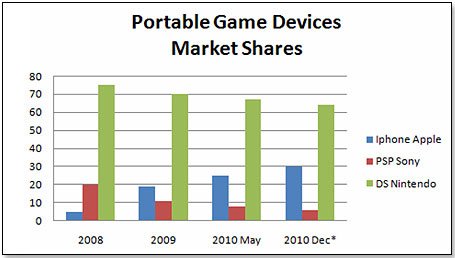
December 16, 2025


| “If you assume that 30 percent of iPad usage will be devoted to games … this translates to 2.4 million consoles that potentially will not be sold by Sony, Microsoft and Nintendo.” |
 Publishers depended on retailers to move their products but resented the fact that the same retailers — particularly GameStop — made an inordinate amount of money reselling used games, on which the publishers of these games made not a penny. Those publishers also needed the console makers for whom they tailored their products but resented the fact that the same console makers produced games in competition to theirs.
Publishers depended on retailers to move their products but resented the fact that the same retailers — particularly GameStop — made an inordinate amount of money reselling used games, on which the publishers of these games made not a penny. Those publishers also needed the console makers for whom they tailored their products but resented the fact that the same console makers produced games in competition to theirs.  OnLive allows you to play any game “in the cloud” on your PC or Mac [or TV with a converter] by accessing via broadband games stored on OnLive’s servers. There is no need for additional hardware and no need to download anything. Access apparently is instantaneous and seamless via the OnLive website. See “OnLive Threatens Video Gaming As We Know It”
OnLive allows you to play any game “in the cloud” on your PC or Mac [or TV with a converter] by accessing via broadband games stored on OnLive’s servers. There is no need for additional hardware and no need to download anything. Access apparently is instantaneous and seamless via the OnLive website. See “OnLive Threatens Video Gaming As We Know It” 
 comScore, Inc. recently conducted market research among 2,176 Internet users regarding their take on the iPad. They found that 34 percent of males indicated they were likely to use the iPad for playing video games, compared to 28 percent of females. More than 50 percent of 18- to 24-year-olds said they would likely use the iPad for this type of gaming, 15 percentage points above 25- to 34-year-olds, the next highest age group.
comScore, Inc. recently conducted market research among 2,176 Internet users regarding their take on the iPad. They found that 34 percent of males indicated they were likely to use the iPad for playing video games, compared to 28 percent of females. More than 50 percent of 18- to 24-year-olds said they would likely use the iPad for this type of gaming, 15 percentage points above 25- to 34-year-olds, the next highest age group.
Copyright © 2025 TDmonthly®, a division of TOYDIRECTORY.com®,
Inc.